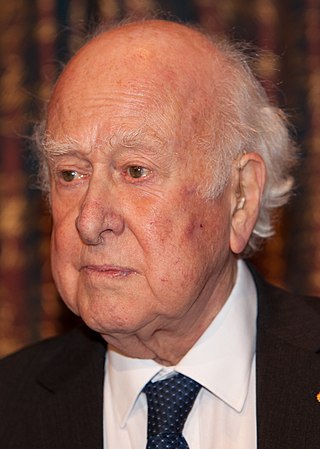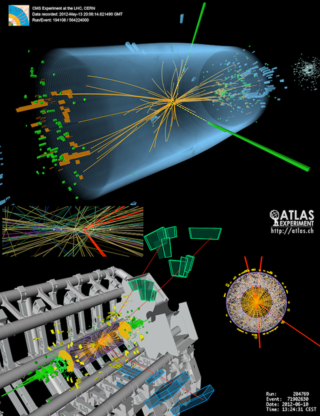Related Research Articles
In physics, the fundamental interactions or fundamental forces are interactions in nature that appear not to be reducible to more basic interactions. There are four fundamental interactions known to exist:

In particle physics, an elementary particle or fundamental particle is a subatomic particle that is not composed of other particles. The Standard Model presently recognizes seventeen distinct particles—twelve fermions and five bosons. As a consequence of flavor and color combinations and antimatter, the fermions and bosons are known to have 48 and 13 variations, respectively. Among the 61 elementary particles embraced by the Standard Model number: electrons and other leptons, quarks, and the fundamental bosons. Subatomic particles such as protons or neutrons, which contain two or more elementary particles, are known as composite particles.

Particle physics or high-energy physics is the study of fundamental particles and forces that constitute matter and radiation. The field also studies combinations of elementary particles up to the scale of protons and neutrons, while the study of combination of protons and neutrons is called nuclear physics.

The Standard Model of particle physics is the theory describing three of the four known fundamental forces in the universe and classifying all known elementary particles. It was developed in stages throughout the latter half of the 20th century, through the work of many scientists worldwide, with the current formulation being finalized in the mid-1970s upon experimental confirmation of the existence of quarks. Since then, proof of the top quark (1995), the tau neutrino (2000), and the Higgs boson (2012) have added further credence to the Standard Model. In addition, the Standard Model has predicted various properties of weak neutral currents and the W and Z bosons with great accuracy.

Peter Ware Higgs was a British theoretical physicist, professor at the University of Edinburgh, and Nobel laureate in Physics for his work on the mass of subatomic particles.

In particle physics, the W and Z bosons are vector bosons that are together known as the weak bosons or more generally as the intermediate vector bosons. These elementary particles mediate the weak interaction; the respective symbols are
W+
,
W−
, and
Z0
. The
W±
bosons have either a positive or negative electric charge of 1 elementary charge and are each other's antiparticles. The
Z0
boson is electrically neutral and is its own antiparticle. The three particles each have a spin of 1. The
W±
bosons have a magnetic moment, but the
Z0
has none. All three of these particles are very short-lived, with a half-life of about 3×10−25 s. Their experimental discovery was pivotal in establishing what is now called the Standard Model of particle physics.

ATLAS is the largest general-purpose particle detector experiment at the Large Hadron Collider (LHC), a particle accelerator at CERN in Switzerland. The experiment is designed to take advantage of the unprecedented energy available at the LHC and observe phenomena that involve highly massive particles which were not observable using earlier lower-energy accelerators. ATLAS was one of the two LHC experiments involved in the discovery of the Higgs boson in July 2012. It was also designed to search for evidence of theories of particle physics beyond the Standard Model.
Michael Edward Peskin is an American theoretical physicist. He is currently a professor in the theory group at the SLAC National Accelerator Laboratory.

Jonathan Richard "John" Ellis is a British-Swiss theoretical physicist.

The Higgs boson, sometimes called the Higgs particle, is an elementary particle in the Standard Model of particle physics produced by the quantum excitation of the Higgs field, one of the fields in particle physics theory. In the Standard Model, the Higgs particle is a massive scalar boson with zero spin, even (positive) parity, no electric charge, and no colour charge that couples to mass. It is also very unstable, decaying into other particles almost immediately upon generation.

Fabiola Gianotti is an Italian experimental particle physicist who is the current and first woman Director-General at CERN in Switzerland. Her first mandate began on 1 January 2016 and ran for a period of five years. At its 195th Session in 2019, the CERN Council selected Gianotti for a second term as Director-General. Her second five-year term began on 1 January 2021 and goes on until 2025. This is the first time in CERN's history that a Director-General has been appointed for a full second term.

Sir Tejinder Singh Virdee,, is a Kenyan-born British experimental particle physicist and Professor of Physics at Imperial College London. He is best known for originating the concept of the Compact Muon Solenoid (CMS) with a few other colleagues and has been referred to as one of the 'founding fathers' of the project. CMS is a world-wide collaboration which started in 1991 and now has over 3500 participants from 50 countries.

Sau Lan Wu is a Chinese-American particle physicist and the Enrico Fermi Distinguished Professor of Physics at the University of Wisconsin-Madison. She made important contributions towards the discovery of the J/psi particle, which provided experimental evidence for the existence of the charm quark, and the gluon, the vector boson of the strong force in the Standard Model of physics. Recently, her team located at the European Organization for Nuclear Research (CERN), using data collected at the Large Hadron Collider (LHC), was part of the international effort in the discovery of a boson consistent with the Higgs boson.

Peter Jenni, is an experimental particle physicist working at CERN. He is best known as one of the "founding fathers" of the ATLAS experiment at the CERN Large Hadron Collider together with a few other colleagues. He acted as spokesperson of the ATLAS Collaboration until 2009. ATLAS is a world-wide collaboration which started in 1992 involving roughly 3,000 physicists at 183 institutions in 38 countries. Jenni was directly involved in the experimental work leading to the discoveries of the W and Z bosons in the 1980s and the Higgs boson in 2012. He is (co-)author of about 1000 publications in scientific journals.

The idea that matter consists of smaller particles and that there exists a limited number of sorts of primary, smallest particles in nature has existed in natural philosophy at least since the 6th century BC. Such ideas gained physical credibility beginning in the 19th century, but the concept of "elementary particle" underwent some changes in its meaning: notably, modern physics no longer deems elementary particles indestructible. Even elementary particles can decay or collide destructively; they can cease to exist and create (other) particles in result.
Mayda Velasco is a physicist and professor in the Department of Physics and Astronomy at Northwestern University. She works in experimental particle physics and is a leading member of the CMS Collaboration at the CERN LHC. She founded COFI and is its first director. She is a pioneer in the physics potential of photon colliders.

Jonathan Mark Butterworth is a Professor of Physics at University College London (UCL) working on the ATLAS experiment at CERN's Large Hadron Collider (LHC). His popular science book Smashing Physics, which tells the story of the search for the Higgs boson, was published in 2014 and his newspaper column / blog Life and Physics is published by The Guardian.
Michel Della Negra is a French experimental particle physicist known for his role in the 2012 discovery of the Higgs Boson.
William Joseph Marciano is an American theoretical physicist, specializing in elementary particle physics.
Sarah Demers is an American physicist and the Horace D. Taft associate professor of physics at Yale University.
References
- 1 2 3 "2002 Edward A. Bouchet Award Recipient". American Physical Society. Retrieved October 20, 2020.
- 1 2 3 "Physicist credits his Tillar roots". Arkansas Democrat Gazette. November 7, 2016. Retrieved October 20, 2020.
- 1 2 "Oliver Keith Baker - Physicist of the African Diaspora". www.math.buffalo.edu. Retrieved 2021-03-14.
- 1 2 3 4 5 "Oliver Baker". The History Makers. March 10, 2013. Retrieved October 20, 2020.
- ↑ "Physics Expands by Five Profs". Yale Daily News. September 6, 2006. Retrieved October 20, 2020.
- ↑ The ATLAS Collaboration, "Observation of a new particle in the search for the Standard Model Higgs boson with the ATLAS detector at the LHC", Phys. Lett. B 716:1-29 (2012).
- ↑ O. K. Baker and R. J. Anantua, "TeV gamma rays from distant BL Lacs and photon-paraphoton kinetic mixing" Phys. Lett. B 290:25-28 (2010)
- ↑ "Wright Laboratory". Yale. 2020. Retrieved October 20, 2020.
- ↑ "Keith Baker appointed the D. Allan Bromley Professor of Physics". Physics Department, Yale University. April 13, 2021.
- ↑ "Edward A. Bouchet Award". American Physical Society. 2002. Retrieved 20 October 2020.